What if your city felt like a lush forest, even among skyscrapers? Thanks to Stockholm Tree Pits, urban jungles can become real forests. As our world becomes more urbanized, introducing nature into city life isn’t just a trend—it’s a necessity.
The concept of urban reforestation and innovative solutions like Stockholm Tree Pits are leading this green revolution. Designed in Sweden to seamlessly integrate sturdy trees into urban landscapes, tree pits are a marvel of green infrastructure representing a commitment to sustainability, resilience, and a healthier planet.
Stockholm is setting the gold standard for balancing urban development with thriving green spaces. By greening urban environments, we’re reducing pollution, cooling down hot city streets, and creating spaces that foster community and well-being. Let’s more deeply explore the intriguing concept of Stockholm Tree Pits and discover their role in the vibrant movement of urban greening. These innovative systems not only enhance city landscapes but also contribute to ecological health and community well-being.
What Are Stockholm Tree Pits? The Secret to Greener Cities
Stockholm Tree Pits are innovative green infrastructure solutions designed to support healthy tree growth in cities by improving soil quality and stormwater management. Developed by visionaries in Sweden, these tree pits use innovative techniques and materials, like structural soils and biochar, to mimic natural conditions in an urban environment. They enable trees to stretch their roots without disrupting sidewalks or utility lines, a crucial aspect for cities where space is at a premium.
The ingenious use of biochar—a charcoal-like substance known for its ability to retain water and nutrients—enhances the health of the soil, promoting robust tree growth in less-than-ideal conditions. Stockholm Tree Pits, combined with gravel and other structural soils, offer an innovative solution for urban planting. This method ensures that city trees not only survive but truly thrive, enhancing urban biodiversity and improving air quality.
How Do Stockholm Tree Pits Help Trees Grow in Cities?
Stockholm Tree Pits use an advanced layering system to support urban tree planting, improving stormwater management and ensuring sustainable tree growth in cities. Carefully constructed, the growing media layers incorporate biochar and structural soil to support tree growth. Let’s break down the process to see how each component plays its part in fostering healthy urban trees:
Layered Design for Optimal Growth
Installing a Stockholm Tree Pit starts with excavating a planting site and replacing compacted urban soil with biochar-enriched structural soil to promote deep root growth.
- By digging deep, the tree pit allows room for natural root expansion.
- At the base, biochar is laid to enhance soil vitality, working like a sponge to hold moisture and nutrients—a vital trick for urban settings where rainfall might not reach under paved roads.
- Structural soil follows next, composed of larger stones that provide structural support and resist compaction, ensuring that as the tree roots seek space, they won’t disrupt paved surfaces. This layer is engineered to let roots breathe so trees can breathe easy, too.
Water Management and Aeration
Stockholm Tree Pits help trees stay hydrated while preventing flooding and soil erosion—making cities greener and more resilient. Incorporating systems that allow stormwater to be naturally diverted into the pit means trees are irrigated efficiently without wasting this precious resource. Aeration wells are often added, providing pathways for air and water flow, addressing both plant health and urban drainage issues—a true win-win for sustainable cities.
Why Cities Need Stockholm Tree Pits Right NowStockholm Tree Pits do more than just support trees—they improve cities in big ways:
- Cleaner air by filtering pollutants.
- Cooler streets by reducing urban heat.
- Flood prevention through stormwater management.
- More biodiversity by creating green habitats.
Stockholm Tree Pits improve air quality, reduce urban heat, prevent flooding, and enhance biodiversity, making cities healthier and more resilient to climate change. These pits manage stormwater more effectively, reducing flood risks during heavy rainfall.
Incorporated thoughtfully, they offer a profound insight into how cities can adapt to climate challenges while enhancing quality of life. From Stockholm’s own bustling avenues to city streets worldwide, this innovative technique is helping urban planners rethink what’s possible, melding green spaces with grey for cities that truly represent the best of both worlds.
Understanding the scientific benefits that Stockholm Tree Pits provide reveals that taking action to make greener urban landscapes goes beyond mere aesthetics. This revolutionary act is about cultivating healthier, happier environments where communities can truly thrive. Using this simple planting method fosters improved air quality, enhances biodiversity, and creates inviting spaces for all residents.
Quick Key Points and Questions
- ✅ Q: What is the purpose of Stockholm Tree Pits?
- A: They allow trees to grow in cities by preventing soil compaction & managing stormwater.
- ✅ Q: Can I install a tree pit in my backyard?
- A: Yes! While mainly for cities, you can adapt this system for residential use.
- ✅ Q: Are tree pits expensive?
- A: Costs vary, but their long-term benefits outweigh the initial investment.
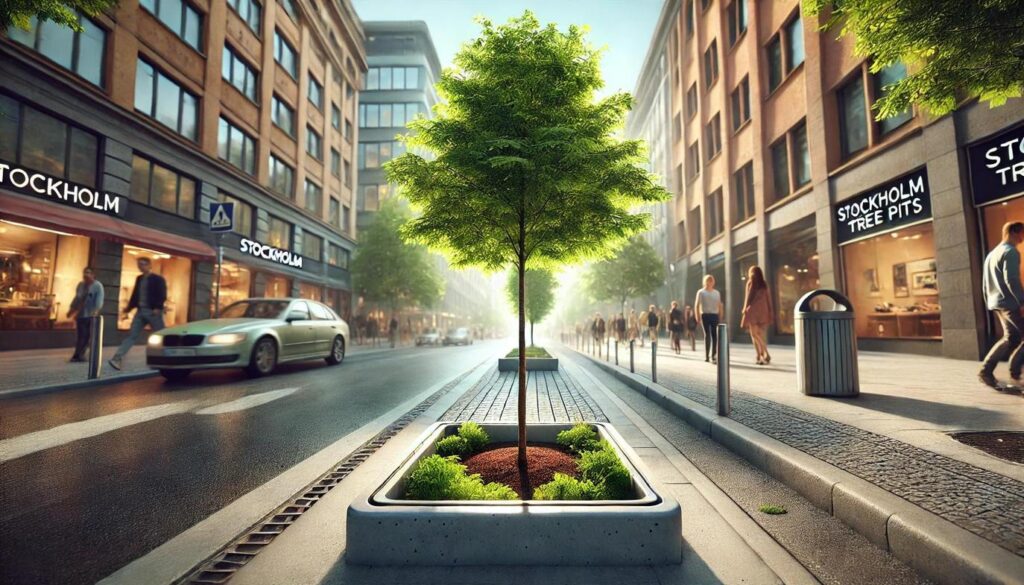
The Benefits of Urban Forestry with Stockholm Tree Pits
Environmental Advantages
Embracing urban greening with solutions like Stockholm Tree Pits introduces significant environmental benefits to cities. One of the most vital contributions is air quality improvement. Trees filter pollutants from the air, absorbing gases like nitrogen dioxide and carbon monoxide, which are common in urban atmospheres. Moreover, trees capture and store carbon dioxide, a primary greenhouse gas driving climate change, thus contributing to lower urban carbon footprints.
Beyond the air, tree pits play an essential role in managing urban water cycles. By incorporating systems that direct stormwater into the soil, they reduce runoff and the risk of flooding, which is crucial in concrete-laden urban environments. This not only prevents local flooding during heavy rains but also helps replenish local groundwater reserves.
Social and Economic Benefits
The advantages of incorporating Stockholm Tree Pits extend beyond environmental salvation—they offer valuable social and economic perks as well. City neighborhoods with abundant green spaces tend to experience lower crime rates. The presence of urban greenery fosters community interactions and peaceful environments, which discourage potential criminal activity.
On an economic front, beautifying urban areas with lush, healthy trees, courtesy of Stockholm Tree Pits, can significantly enhance property values. Neighborhoods adorned with well-maintained greenery attract more residents and businesses, boosting local economies. Furthermore, these green environments promote health and mental well-being for residents, reducing healthcare costs and fostering more vibrant communities.
Biodiversity Enhancement
Lastly, Stockholm Tree Pits contribute to increased urban biodiversity. By supporting a variety of plant life suitable for urban settings, these pits create habitats for a range of wildlife, including insects, birds, and other beneficial organisms. Biodiversity is essential for pollination and maintaining ecological balance within city landscapes, helping to bring nature’s elegance into our built environment.
Uniting environmental stewardship with socioeconomic progress, urban greening initiatives like Stockholm Tree Pits pave the way for a sustainable and resilient future in our cities. Let’s explore how you can embrace this transformative approach in your own community.
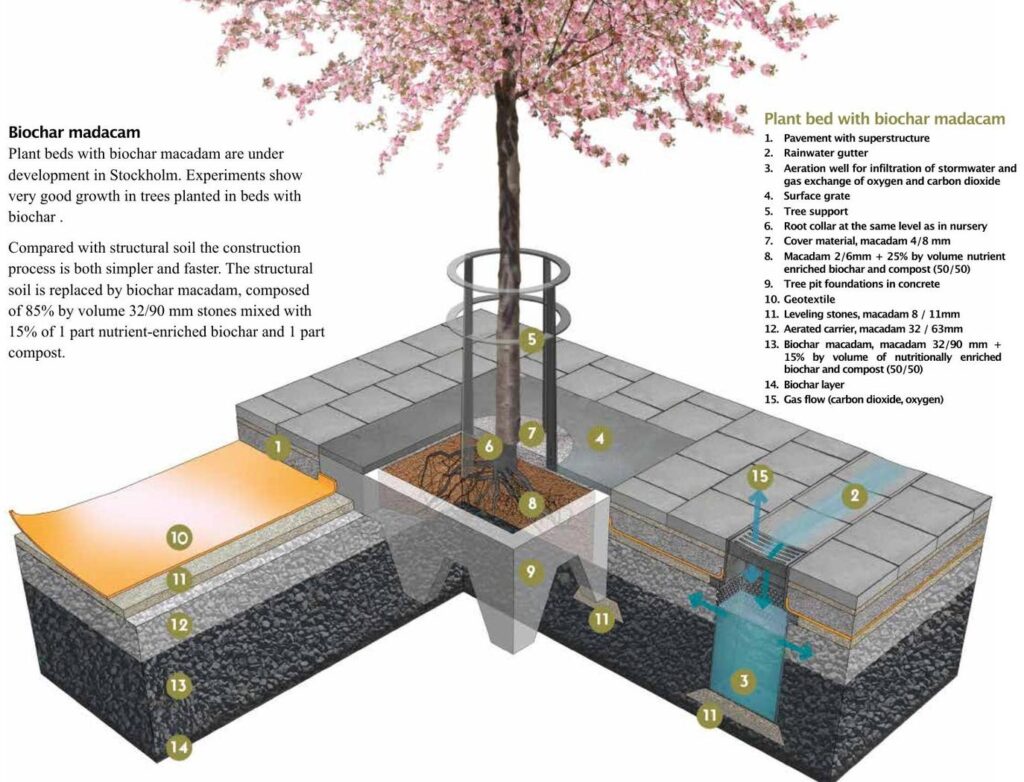
DIY Guide: How to Install a Stockholm Tree Pit
Want to plant trees that thrive in urban environments while helping with stormwater management, air purification, and climate resilience? This Stockholm Tree Pit installation guide walks you through a step-by-step process to create a sustainable and long-lasting tree pit that improves urban forestry.
Step 1: Planning & Site Preparation
Site Assessment: Choosing the Right Location
Before digging, evaluate your planting site:
- ✅ Soil Type: Test for compaction and nutrient availability.
- ✅ Water Drainage: Ensure rainwater can reach the roots.
- ✅ Nearby Infrastructure: Avoid underground utility lines and building foundations.
A well-prepared site prevents future tree health problems and ensures long-term growth.
Soil Testing & Documentation
- Take pictures at every stage to track progress.
- Conduct a soil analysis for compaction, pH levels, and nutrient content.
Step 2: Excavation & Subgrade Preparation ⛏️
Digging the Tree Pit
- Excavate a pit deep enough to allow root expansion while avoiding underground pipes and cables.
- Remove compacted soil to improve root penetration and aeration.
- Ensure a stable base to prevent future soil shifting.
Improve Water Retention with Biochar
- Lay a 50mm biochar layer at the base to improve moisture retention and soil fertility.
- Biochar prevents soil erosion and enhances microbial activity, promoting tree health.
Subgrade Adjustments
- If needed, install a geomembrane liner to reduce water loss and soil contamination.
- Loosen compacted soil at the bottom of the pit to help roots establish faster.
Step 3: Installing the Structural Soil Layers ️
A well-structured soil layering system prevents sidewalk damage and ensures deep root penetration.
Layer 1: Base Biochar Mix (Soil Improvement Layer)
- Spread 50mm of biochar across the base for water retention and nutrient storage.
- Helps trees resist urban heat and pollution stress.
Layer 2: Crushed Macadam Stones (90/150mm)
- Add a 250-300mm layer of large crushed stones (macadam) to support tree stability.
- Prevents soil compaction while allowing air and water movement.
Layer 3: Soil Infusion for Root Health
- Flush soil into the spaces between stones using high-pressure water.
- Ensures even nutrient distribution and prevents air pockets.
- Repeat layering until the pit reaches the required depth.
✅ Why This Works?
This layered approach reduces urban flooding, boosts tree growth, and prevents cracked sidewalks caused by expanding roots.
Step 4: Installing Additional Support Systems
Ensuring a Stable Tree Pit Foundation
Use smaller macadam stones for the final leveling layer.
Adjust layers to prevent long-term settling.
Adding an Aeration Well
- Install an aeration pipe to allow oxygen and water infiltration.
- Prevents waterlogging and root suffocation.
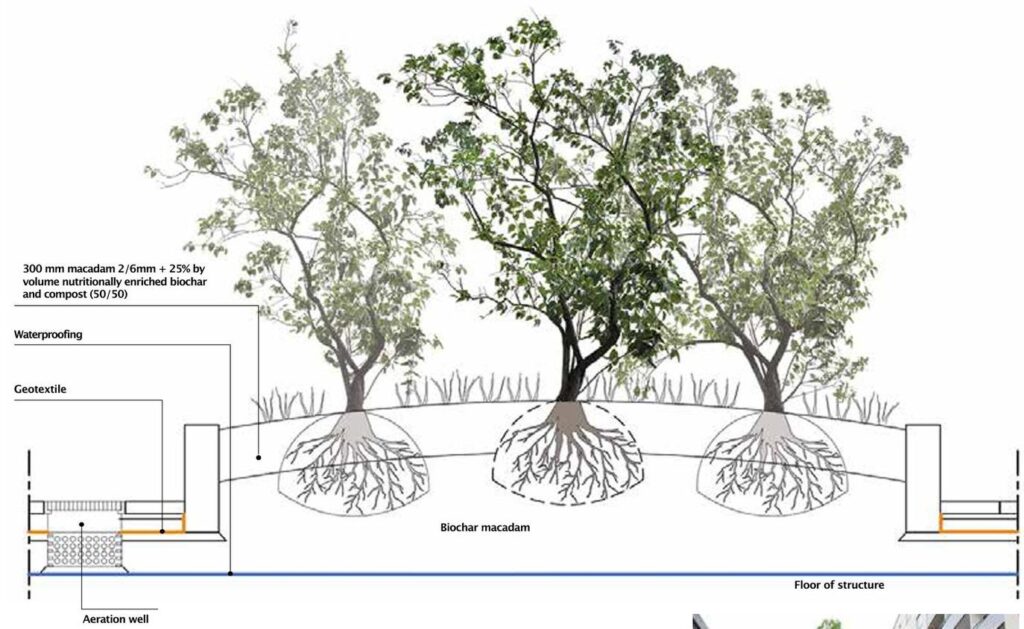
Step 5: Planting the Tree & Root Ball Placement
Positioning the Tree for Maximum Growth
- Place the tree at the same depth as in the nursery.
- Ensure roots have enough space for lateral growth.
Protecting the Roots & Enhancing Soil Quality
- Remove restrictive netting around the root ball.
- Fill the root zone with a biochar-macadam mixture to lock in moisture and nutrients.
Tree Support & Protection
- Install tree guards and stakes to prevent damage from pedestrians and urban traffic.
- Use webbing to secure the tree without restricting natural movement.
Step 6: Final Surface Layer & Completion ✅
Covering & Compacting the Surface
- Add a 50mm macadam top layer for protection.
- Ensure proper compaction to prevent erosion and maintain stability.
Installing a Tree Grille (Optional)
- In high-traffic areas, use tree grilles to protect the soil and support foot traffic.
- Choose materials that allow rainwater infiltration.
Final Inspection Checklist
- ✅ Aeration well placement confirmed?
- ✅ Are tree guards and grilles properly installed?
- ✅ Soil compacted but not over-packed?
- Your tree pit is now ready to support urban greenery!
Step 7: Maintenance & Long-Term Care
Watering & Soil Monitoring
- Regular watering during the first 2 years is critical for root establishment.
- Check for signs of drought stress (wilting, dry leaves).
Cleaning the Aeration Well
- Remove debris from aeration pipes to ensure proper water and air circulation.
- Check for any blockages every 6 months.
Fertilization & Soil Nutrient Management
- Apply organic fertilizers or compost once a year to replenish nutrients.
- Avoid chemical fertilizers that can disrupt soil microbial life.
- ✅ Tip: Want to keep your trees thriving? Mulch around the base to conserve moisture and suppress weeds.
Why Stockholm Tree Pits Matter
Planting a tree isn’t just about digging a hole—it’s about creating a thriving ecosystem that supports cleaner air, cooler cities, and sustainable urban development.
By installing a Stockholm Tree Pit, you are
- ✅ Improving urban tree health and longevity.
- ✅ Reducing stormwater runoff and preventing floods.
- ✅ Enhancing air quality and cooling city streets.
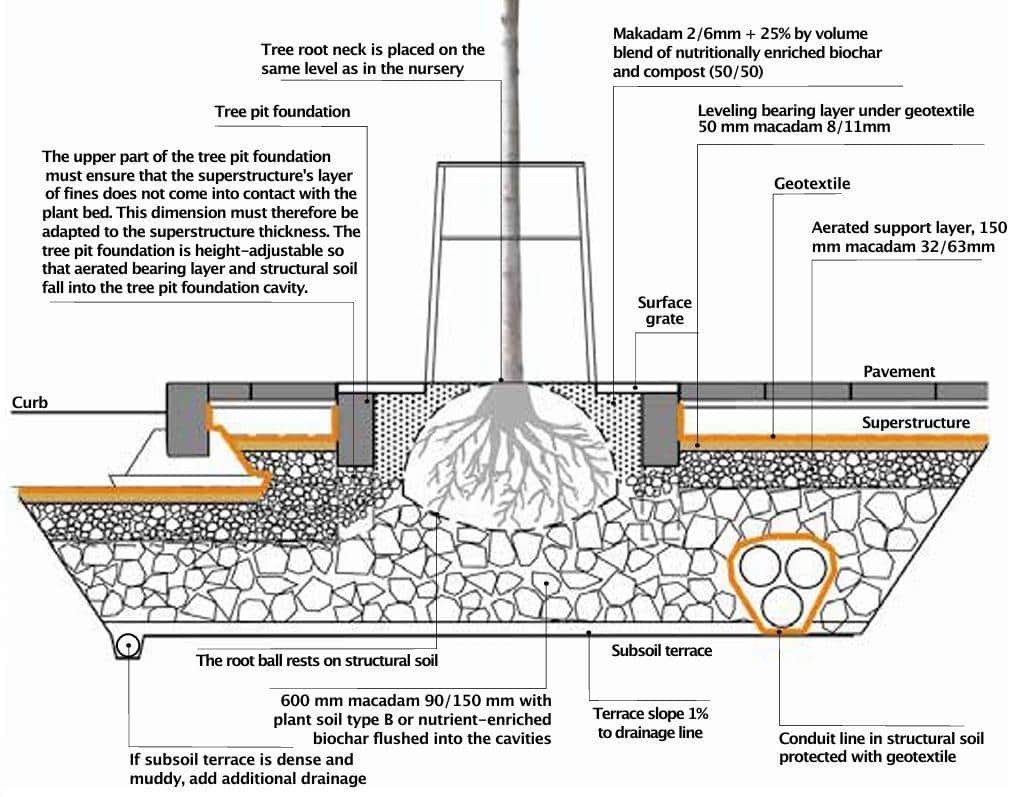
Stockholm Tree Pits are The Future of Urban Forestry
The Vision of Urban Resilience
As urban populations swell, cities encounter unprecedented challenges—climate change, air pollution, and infrastructure strain, just to name a few. In major cities, Stockholm Tree Pits shine as beacons of sustainable innovation. By enhancing air quality, managing stormwater, and promoting urban biodiversity, these tree pits play a vital role in building resilient urban ecosystems. They serve as essential components of sustainable city planning, creating healthier environments for both people and wildlife.
Integration with Smart City Solutions
Stockholm Tree Pits are more than just an aesthetic addition; they can be seamlessly integrated into broader smart city initiatives. These initiatives encompass everything from reducing carbon footprints to optimizing energy consumption and enhancing public health. By effectively managing water resources and enhancing air quality, tree pits contribute to smarter and more sustainable urban living. These green solutions not only enrich city environments but also support healthier communities and ecosystems.
Supporting Policy and Community Health
With the growing recognition of urban greenspaces in promoting public well-being, cities worldwide are crafting policies to expand green infrastructure. Such frameworks advocate for increased tree canopies using solutions like Stockholm Tree Pits, which not only beautify cities but also significantly enhance local air quality and residents’ quality of life. Implementing these systems is a strategic move that cities can embrace to foster healthier, happier communities.
Incorporating Green Spaces: A Community’s Role
Community Engagement as a Catalyst
Urban greening isn’t just a top-down initiative; communities play a pivotal role in its success. By actively participating in tree planting and maintenance, residents can turn their neighborhoods into greener, more vibrant spaces. Community-driven projects make environmental stewardship tangible and foster a shared sense of responsibility.
Educational Opportunities and Empowerment
Introducing concepts like the Stockholm Tree Pit to schools and communities is an excellent educational tool. It merges practical environmental science with day-to-day learning, empowering the next generation to prioritize sustainability. Programs can encourage students and local volunteers to partake in tree planting, turning theory into action.
The Multiplier Effect
Community-driven efforts in urban greening amplify environmental impact. From neighborhood cleanups to large-scale city initiatives, these collaborative actions yield impressive benefits. They reduce urban heat, boost biodiversity, and strengthen community bonds, transforming living spaces into healthier and more desirable environments.
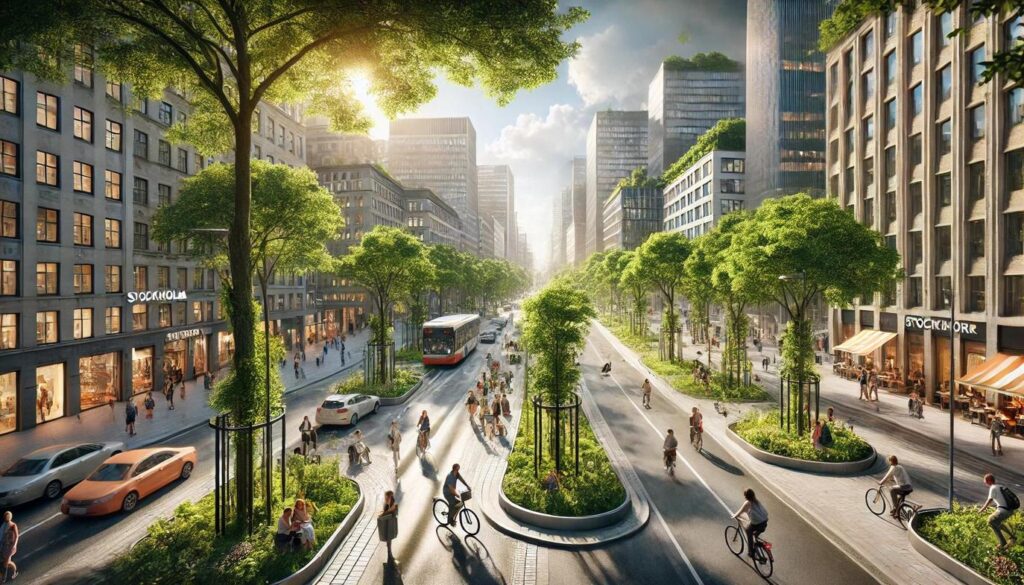
Stockholm Tree Pits FAQs: Your Questions Answered
What are Stockholm Tree Pits Made Of?
Stockholm Tree Pits typically comprise layers of biochar and structural soil (a mix of crushed stones, soil, and organic material) designed to support tree growth and water management in challenging urban environments.
How Do Tree Pits Improve Urban Air Quality?
By facilitating healthy tree growth, the pits allow trees to perform natural filtration of pollutants, capture carbon dioxide, and generate oxygen—resulting in noticeably cleaner urban air.
Can Tree Pits Be Integrated into Existing City Structure?
Yes, tree pits can be retrofitted into existing urban landscapes as part of new development or as enhancements to current infrastructure. This flexibility makes them suitable for integrating into various urban planning projects.
Why Stockholm Tree Pits Are Key to Urban Greening
Imagine cities where tree-lined boulevards and bursting pockets of greenery naturally blend with urban surroundings. Stockholm Tree Pits make this possible, transforming harsh landscapes into verdant habitats that support life, reduce stress, and foster community.
Through innovative design and collaborative effort, cities can extend their green footprints and enjoy myriad environmental and societal benefits. The path to a greener tomorrow lies in solutions like Stockholm Tree Pits, which encourage us all to invest in sustainable urban futures. Want to transform your city with greener, healthier streets? Start planting with Stockholm Tree Pits today and join the urban forestry revolution!




